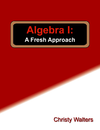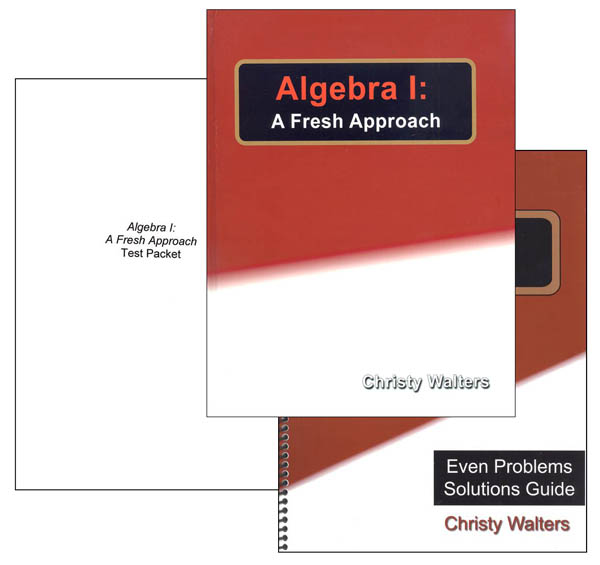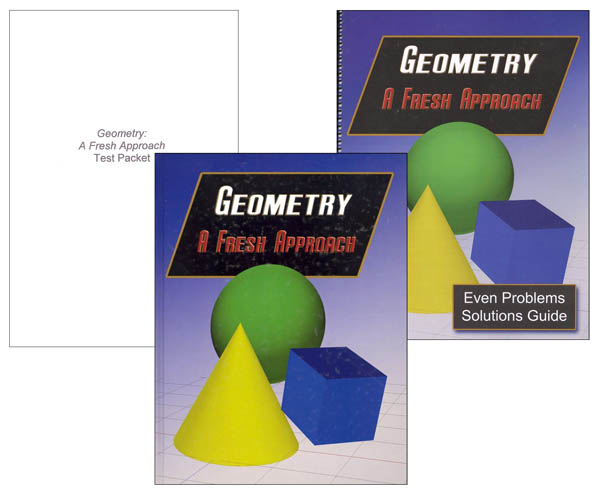The Fresh Approach high school math texts look like typical, hard-cover school textbooks on the outside, but the insides are not typical. Author Christy Walters differentiates her lesson presentation methodology by teaching as few rules as possible. She explains, “In my years of experience, I have found that, the more formulas and rules a student is exposed to, the more likely it is that he or she will get confused. However, given enough practice, almost all students will figure the formulas out on their own, and they will then remember the formulas and understand them much better than if they had been taught them” (Preface to Algebra I). Walters implements this philosophy in Algebra I and Algebra II but seems to revert to a more traditional philosophy in Geometry.
In the algebra texts, most lessons begin with relatively brief teaching of a new concept, generally followed by not just one, but perhaps up to six examples with thorough explanations. Examples sometimes use real situations or applications that make it easier to grasp what you are trying to accomplish. Walters teaches by “showing” through the examples rather than just presenting information. Examples are followed by many practice problems so that students master each concept. The Geometry lessons include detailed explanations and examples but these are generally prefaced with more teaching and presentation of postulates and theorems.
Walters’ teaching style is “user-friendly” with a conversational tone. She walks students through concepts as if she were sitting next to them, noting pitfalls to avoid or potential difficulties to which students should be alert. In reading through a sampling of lessons, I found them very understandable. For example, her introductory presentation on functions in Algebra I is one of the most lucid I’ve seen. However, this series is still more challenging than others such as Teaching Textbooks both because of the concepts covered and the mathematical language it uses.
For each course, the text is divided into chapters, and chapters are divided into “Parts.” Each Part teaches a single concept. While texts sometimes teach complex topics in stages, they complete one topic before moving on to another. Each chapter concludes with a mixed review of concepts taught up to that point. If you purchase the test packet for each course, you will have a test for the end of each chapter. Most of the Algebra I tests include a section of cumulative review problems from previous chapters, but the Geometry and Algebra II tests do not. There are no mid-terms or finals. The test packet includes the complete solution keys for all tests.
Each text includes answers to odd-numbered problems in the back. Solutions Guides have complete solutions to only the even-numbered problems. This provides all of the answers but it is a bit of a bother to have to go to both sources to check answers. You could have students self-check odd-numbered problems themselves in their text, leaving you to check only even-numbered problems in the Solutions Guide.
In addition to a somewhat unique teaching methodology, the visual layout also differs from standard hardcover texts. The books are “plain” on the inside, printed in black and white with no decorative illustrations or graphics. The typeface is a fairly large, sans-serif font. While the font is easy to read and pages are not overly crowded, there is still a lot of material. The page size is 8.5 x11 inches and books range from an inch and half to two inches in thickness. But, surprisingly, these hardcover books are designed to be used as consumable textbooks. There is space for students to answer questions directly in each text, including writing out geometry proofs. I wouldn’t recommend trying to have students write answers in a separate notebook since that would require recopying problems, using up students’ energy that is better spent on problem solving.
The choice to print these student worktexts as hardcover books seems very practical since books this size put a lot of strain on the binding, and soft cover books can start to lose pages part way through the course. The hardcover books lie fairly flat, although not completely. Still, it’s enough for students to easily be able to write in them.
The books lack indexes, but the tables of contents in each book list topics for both chapters and parts within chapters, so they can be used to locate topics. This is not as convenient as indexes and doesn’t help with searches such as one I did to find where calculators are introduced. (I found calculators referenced only a few times in Algebra II in the sections on exponential equations and logarithms but not at all in the other two courses.)
Author Christy Walters has created some free videos available on this webpage under "More Information." You'll find videos on positive and negative numbers, fractions, decimals, geometric proofs, and a few other topics.
A+ Education Services also sells a number of Quick Reference Guides, laminated folders with key concepts and formulas for algebra, geometry, and trigonometry.
Algebra I
Algebra I covers standard topics, but it is slightly ahead of some other programs with an entire chapter on functions found only half way through the course. The first three chapters are intended to serve as review of number operations, absolute value, negative numbers, variables, exponents, fractions, expressions, the distributive property, and equations. These chapters assume that students have already been exposed to these concepts since they move rather quickly from simple to complex applications. The text continues through topics such as irrational numbers, roots, word problems, inequalities, graphs in the coordinate plane, systems of equations and inequalities, operations with monomials and polynomials, factoring, and solving quadratic equations. The final chapter covers statistics and probability.
The 2016 edition of this book has almost 200 pages more than the 2005 edition. In addition to the final unit on statistics and probability that wasn't in the previous edition (61 pages), explanations have been expanded throughout the book. For the most part, this is just an added sentence or expanded example here or there, but it adds up over the span of the entire book. Since statistics and probability seem to be emphasized in math courses across the board throughout early grades as well as at high school level, the last chapter is an important addition to the text.
Geometry
Geometry seems to take a different approach than the algebra texts. It seems much more “rule oriented” as it presents postulates and theorems in an abstract fashion. It begins with a chapter on logic that introduces proofs using algebraic problems rather than geometry since students should already be familiar with the algebra. The second and third chapters cover points, lines, and planes and their related postulates and theorems while also introducing line segments and angles, parallel lines and planes. It continues through other standard topics, but it introduces trigonometry in chapter eight (of thirteen chapters in all). However, it does not integrate trigonometry into subsequent chapters. Proofs are used extensively throughout the course.
A Companion DVD packaged inside the front cover of the text teaches students how to work with a protractor, how to view drawings of three-dimensional shapes, and the differences between perimeter, area, and volume. Most students will have already learned most of this by tenth grade, but it’s helpful for those who haven’t.
I had originally complained about the lack of construction activity in this course. To remedy that, Walters has added a free video on constructions with sections correlating to lesson material in chapters 2, 3, 5, 6 and 9. The video is accessed through her website. Directly below links to supplemental videos are links to PDF files. Here you will find a 21-page file with activity pages for the constructions taught in the video. I've always believed that geometry students understand many concepts much better when they work through constructions themselves, so this is a nice addition to the course. Note that, going forward, the supplemental videos will be included on the DVD that is packaged with the textbook.
This is a challenging course, but it is written with thorough explanations so that students can work independently. The Geometry course requires students to apply algebra. An appendix includes 45 pages of algebra review with practice problems for students who need to review or for those who just want to keep their algebra skills sharp.
Algebra II
While Walters’ algebra courses are light on rules, in Algebra II this is offset by a healthy dose of mathematical vocabulary and more challenging content than many other courses. (Saxon’s new Algebra 2 is fairly comparable although Saxon incorporates use of a calculator throughout the course.) Walters’ Algebra II has two full chapters on functions, a chapter on matrices, an entire chapter on logarithmic equations and functions, a chapter on sequences and series, two chapters on probability and data analysis, and an entire chapter at the end on trigonometry.















